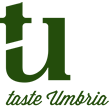- Eat & Drink
- Umbrian flavours
- Cheeses
Umbria boasts ancient traditions both as regards pastoralism and cheese making. In fact, already Pliny the Elder (1st century AD) in Natural History, speaking of the quality and provenance of the various cheeses known in Rome, cites the pecorino of Umbria with the appellative of "sansinate".
In the Umbrian dairies we can see how the cheese is treated, using the most modern technologies but, at the same time, respecting the old traditions with the use of natural ingredients and adopting ancient ritual gestures, such as the manual handling of the cheese shapes.
Due to the low presence of plains, sheep cheeses are the best.
The town of Norcia, famous throughout the world for the production of truffles, offers a large part of the range of cheeses of the region with its Pecorino and ricotta salata, as well as the caciotta with truffles, a typical product of the Umbrian woods. Among the soft cheeses with soft dough, we recommend Ravaggiolo Umbro, produced in the first six months of the year and consumed fresh after having it rested for a few days in fern leaves.
Cacio Fiore is a very traditional cheese produced from the best cow's milk from the spring period. It is packaged in fresh caciotta with a delicate flavor and, together with cured meats, is the greedy soul of the typical Umbrian appetizer. In the local gastronomic tradition, the most precious flower cheese is that coming from the Pian di Chiavano area near Cascia, thanks to the unique aroma that the pastures of the area manage to give it.
Giuncata is a curd of whole milk that is slowly tightened in canestrelli di rattan, hence the name. It is used to taste it with sugar and cinnamon and is the typical ritual cheese, particularly common in Valnerina, where it was prepared for the Ascension festivities.
Pecorino di Norcia is the top of the Umbrian dairy production and represents an excellence in a sector in which sheep's milk is dominant compared to the vaccine. The area of origin is the Piana di Castelluccio, where they grow wild aromatic plants such as watercress and wild celery that will allow Pecorino di Norcia to have its unmistakable flavor. At the end of the aging in the cellar of about twelve months, you get a cheese with straw yellow, crumbly and spicy paste.
The sheep's ricotta is a delicate and traditionally widespread product in the pecorino selection areas. After making the pasta for the typical cheese of Norcia, the liquid left in the "caldara", called "scaciatu", is heated to 90-92 degrees until the appearance of the ricotta flakes. Once it has been foamed, it is placed in fuscelle di giunco which favor its draining, the so-called "scotta".
Even today, ricotta is present in some rites and folk traditions of Valnerina and the Apennine Umbrian ridge. In Cascia, for example, on the day of the feast of S. Antonio Abate on 17 January, portions of ricotta topped with liqueur are distributed to the population.

